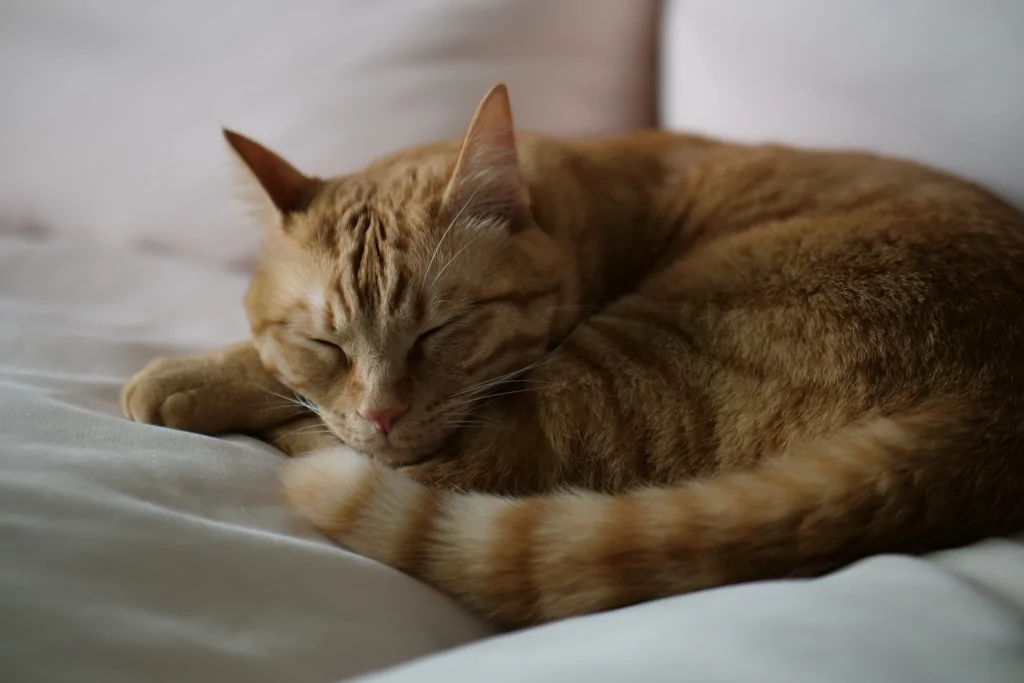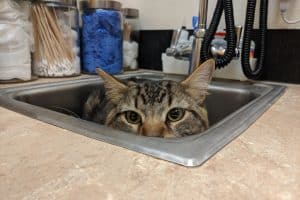Note: We may earn a commission from helpful, relevant links in our content. No cost to you. See our privacy policy.
As a loving cat owner, it’s only natural that you want your feline friend to live a happy and healthy life. But sometimes, despite our best efforts, our cats can become sick or injured.
Detecting the subtle signs of illness or injury in our furry companions is not always easy, especially since our feline friends are known for their stoic nature.
In this article, we’ll guide you through the process of identifying those telltale signs and taking proactive steps to ensure the well-being of your beloved cat.

Recognizing Signs of Illness or Injury in Your Cat
Cats are masters of disguise when it comes to hiding their discomfort.
However, by paying close attention to your cat’s behavior, appearance, and daily habits, you can spot the signs that something might be amiss. Here are some key indicators to watch for:
- Changes in Appetite and Thirst. A sudden increase or decrease in your cat’s appetite or water consumption could signal a health issue. This might include weight loss, weight gain, or dehydration.
- Altered Grooming Habits. Cats are meticulous groomers. If you notice your cat grooming excessively, neglecting to groom, or developing matted fur, this could be a sign of pain, skin issues, or other health problems.
- Unusual Vocalizations. If your cat suddenly becomes more vocal, or if their meows change in pitch or frequency, they might be trying to tell you that they’re in pain or feeling unwell. Check our guide for insights on cat vocalizations.
- Lethargy or Reduced Activity. Cats are known for their napping habits, but if your cat is sleeping more than usual, shows a lack of interest in play, or seems to have a decrease in energy levels, this could indicate an underlying health issue.
- Changes in Bathroom Habits. Keep an eye on your cat’s litter box habits. Frequent urination, constipation, diarrhea, or blood in urine or feces could signal a problem that requires veterinary attention.
- Unexplained Hiding or Isolation. Cats may withdraw from their normal social interactions when they’re feeling unwell. If your cat is suddenly hiding more often or avoiding human contact, it’s time to investigate further.
By staying vigilant and monitoring your cat’s behavior and appearance, you’ll be better equipped to recognize when something is amiss and take prompt action to address the issue.
When to Call the Vet: Seeking Professional Help
As cat owners, we sometimes find ourselves wondering if a particular symptom or behavior warrants a call to the vet.
It’s important to trust your instincts when it comes to your cat’s health, and never hesitate to seek professional help if you’re unsure. Here are some situations when it’s crucial to consult your vet:
- Persistent Symptoms. If your cat is displaying symptoms of illness or injury that persist or worsen over time, it’s essential to consult your vet. Conditions like ongoing vomiting, diarrhea, or coughing could indicate a more serious health issue.
- Difficulty Breathing. Any signs of labored breathing, wheezing, or rapid breathing in your cat should be treated as an emergency. These symptoms could indicate a respiratory issue, heart problem, or other life-threatening conditions.
- Trauma or Injury. If your cat has experienced a significant injury, like a fall or a fight with another animal, it’s important to have them examined by a veterinarian. Even if your cat seems fine, internal injuries could be present.
- Pain or Discomfort. If your cat appears to be in pain or is experiencing discomfort that cannot be easily explained, it’s best to consult your vet. They can help diagnose the issue and provide appropriate treatment options.
Personal Experience:
Remember, it’s always better to err on the side of caution and consult with your vet when you’re concerned about your cat’s well-being. They have the expertise and resources to accurately diagnose and treat your feline friend, ensuring their ongoing health and happiness.
If, however, you’re looking to change your vet, follow our guide to choosing the best vet for your cat.

Administering Medications with Tips for Success
Giving medications to your cat can be a challenging task, but with the right techniques and some patience, you can help ensure your feline friend receives the treatment they need. Here are some useful tips to make administering medications to your cat easier and more successful.
Choose the Right Delivery Method
Different medications come in various forms, such as pills, liquids, or even topical treatments.
To make administering liquid medications easier, consider using a small syringe without a needle or a dropper to accurately measure the dosage. Gently insert the tip into the side of your cat’s mouth and slowly release the medication, allowing them to swallow. Be patient and offer praise or treats to create a positive association with the process.
Talk to your vet about the best delivery method for your cat’s specific needs, and consider any known preferences your cat may have.
Hide the Medication in Food
One common technique for giving pills to cats is hiding the medication in a treat or a small portion of wet food. This can help mask the taste and make it more appealing for your cat to ingest.
You can also purchase specially designed pill pockets or treats that have a built-in space for the medication. For example, these Feline Greenies Pill Pockets are excellent examples of treats containing pill pockets for medicine tablets or capsules.
Use a Pill Dispenser
A pill dispenser is a handy tool designed to make administering pills to your cat more manageable.
These devices hold the pill securely and allow you to place it directly into the back of your cat’s mouth, making it easier for them to swallow.
A highly-rated pill dispenser for cats is the Kruuse Buster Pet Pill/Tablet Syringe. This easy-to-use device features a soft rubber tip that is gentle on your cat’s mouth, making it more comfortable for them as you administer the pill.
Remain Calm and Patient
Cats can sense our emotions, so it’s essential to remain calm and patient while giving medications.
Avoid forcing the medication on your cat, as this can cause stress and make the process more difficult for both of you. Instead, be gentle and reassuring, praising your cat when they cooperate.
Establish a Routine
Creating a consistent routine around administering medications can help your cat become more accustomed to the process. Try to give the medication at the same time each day and in the same location.
This predictability can help reduce stress and make it easier for your cat to accept the treatment.
By following these tips and working closely with your veterinarian, you can make the process of administering medications to your cat smoother and more successful. Remember, your patience and dedication play a significant role in helping your feline friend recover and maintain their health.
Supporting Your Cat Through Recovery with Love and Patience
Helping your cat recover from an illness or injury requires understanding, love, and patience.
Ensure they have a quiet and comfortable space to rest, away from any loud noises or distractions. Spend time with them, offering gentle strokes and soothing words to provide emotional support. Make sure they eat and drink, and that fresh water is available at all times.
I remember when my cat, Smokey, had surgery. I made sure to stay close to him, offering warmth and comfort, which seemed to help him relax and heal more quickly. Sometimes, just being there for your cat and providing a calm presence can make all the difference in their recovery.
Preventing Future Illness and Injury: Proactive Steps
Here are some actionable steps you can take to protect your cat’s health and happiness while minimizing the risk of illness or injury:
- Schedule regular vet checkups. Routine veterinary visits can help detect and address potential health issues early. I always try to set reminders on my phone or calendar to ensure I don’t miss any appointments.
- Maintain a healthy diet. Provide a balanced and nutritious diet to support your cat’s overall health and immune system.
- Keep your cat active. Encourage regular exercise and playtime to help maintain your cat’s physical and mental well-being. Introduce interactive toys or engage in play sessions with a variety of toys to keep your cat entertained and stimulated.
- Provide a safe environment. Cat-proof your home by removing potential hazards, such as toxic plants, loose wires, and small objects that could be swallowed.
- Monitor your cat’s behavior. Stay alert for any changes in your cat’s behavior or appearance that might indicate a health issue, and address concerns promptly with your vet. Keep a journal of your cat’s habits and routines to help you identify any changes in their behavior.
With these tips, and the other advice from this guide, you’ll ensure your furry friend lives a long, happy, and healthy life.
FAQs
How can I help my cat feel more comfortable during recovery?
Ensure your cat has a quiet, comfortable space to rest, and provide gentle physical and emotional support to help them feel safe and relaxed. Always monitor your cat’s food and water intake, as they would sometimes stop eating and drinking during a recovery.
Are there alternative treatments for pain management in cats?
Yes, some alternative treatments, such as acupuncture, massage, and herbal remedies, can be used for pain management in cats. Consult your veterinarian before trying any alternative therapies.
How do I know if my cat is experiencing pain or discomfort?
Signs of pain or discomfort in cats include hiding, decreased appetite, vocalizing, lethargy, and changes in behavior or grooming habits.
What can I do to prevent future injuries or illnesses in my cat?
Schedule regular vet checkups, maintain a healthy diet, encourage exercise and play, provide a safe environment, and monitor your cat’s behavior for any changes that might indicate a health issue.
Alex, a passionate animal lover, has experience in training and understanding animal behavior. As a proud pet parent to two dogs and three cats, he founded AnimalReport.net to share insights from animal experts and expand his knowledge of the animal kingdom.









